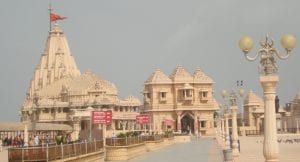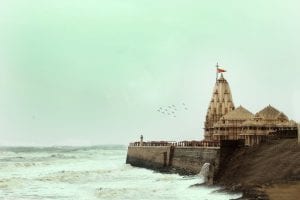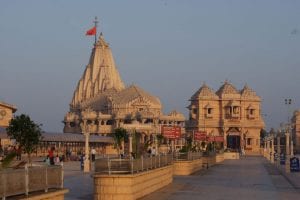આપણું જૂનાગઢ ફેસબુક પેઈજ લાઇક કર્યું ?
somnath temple is located in the Prabhas Patan near Veraval in Saurashtra, on the western coast of Gujarat, India, is one of the twelve Jyotirlinga shrines of the God Shiva. Somnath means “The Protector of (the) Moon God”. The Somnath Temple is known as “the Shrine Eternal”, having been destroyed sixteen times by Muslim invaders. Most recently it was rebuilt in November 1947, when Sardar Vallabhbhai Patel visited the area for the integration of Junagadh and mooted a plan for restoration. After Patel’s death, the rebuilding continued under K. M. Munshi, another minister of the Government of India.The Somnath Temple located in the Prabhas Kshetra near Veraval in Saurashtra, on the western coast of Gujarat, India, is one of the twelve Jyotirlinga shrines of the God Shiva. Somnath means “The Protector of (the) Moon God”. The Somnath Temple is known as “the Shrine Eternal”, having been destroyed sixteen times by Muslim invaders. Most recently it was rebuilt in November 1947, when Sardar Vallabhbhai Patel visited the area for the integration of Junagadh and mooted a plan for restoration. After Patel’s death, the rebuilding continued under K. M. Munshi, another minister of the Government of India.
Legend:
As per Shiv Mahapuran, once Brahma and Vishnu had an argument in terms of supremacy of creation. To test them, Shiva pierced the three worlds as a huge endless pillar of light, the jyotirlinga. Vishnu and Brahma split their ways to downwards and upwards respectively to find the end of the light in either directions. Brahma lied that he found out the end, while Vishnu conceded his defeat. Shiva appeared as a second pillar of light and cursed Brahma that he would have no place in ceremonies while Vishnu would be worshipped till the end of eternity. The jyotirlinga is the supreme partless reality, out of which Shiva partly appears. The jyothirlinga shrines, thus are places where Shiva appeared as a fiery column of light. Originally there were believed to be 64 jyothirlingas while 12 of them are considered to be very auspicious and holy.
Each of the twelve jyothirlinga sites take the name of the presiding deity – each considered different manifestation of Shiva. At all these sites, the primary image is lingam representing the beginningless and endless Stambha pillar, symbolizing the infinite nature of Shiva. The twelve jyothirlinga are Somnath in Gujarat, Mallikarjuna at Srisailam in Andra Pradesh, Mahakaleswar at Ujjain in Madhya Pradesh, Omkareshwar in Madhya Pradesh, Kedarnath in Himalayas, Bhimashankar in Maharastra, Viswanath at Varanasi in Uttar Pradesh, Triambakeshwar in Maharastra, Vaidyanath Jyotirlinga, Deogarh in Deoghar, Jharkhand, Nageswar at Dwarka in Gujarat, Rameshwar at Rameswaram in Tamil Nadu and Grishneshwar at Aurangabad in Maharastra.
Also read Ancient Temples of Junagadh
Significance:
Ancient Indian traditions maintain a close relationship of Somnath with release of Chandra (Moon God) from the curse of his father-in-law Daksha Prajapati. Moon was married to Twenty-Seven daughters of Daksha. However, he favoured Rohini and neglected other queens. The aggrieved Daksha cursed Moon and the Moon lost power of light. With the advice of Prajapita Brahma, Moon arrived at the Prabhas Teerth, built a Shivlinga and worshipped Bhagvan Shiva.
Pleased with the great penance and devotion of Moon, Bhagvan Shiva blessed him and relieved him from the curse of darkness partially letting the periodic waning of the Moon. Lord Shiva decided to rest in that Lingam till eternity, and hence called Jyotirlingam. Pauranic traditions maintain that Moon had built a golden temple, followed by a silver temple by Ravana, Bhagvan Shree Krishna is believed to have built Somnath temple with Sandalwood.
Timeline:
The first temple of Somnath is said to have existed before the beginning of the common era. The second temple, built by the Yadava kings of Vallabhi in Gujarat, replaced the first one on the same site around 649 CE. In 725 CE Junayad, the Arab governor of Sind, sent his armies to destroy the second temple. The Gurjara Pratihara king Nagabhata II constructed the third temple in 815, a large structure of red sandstone.
In 1024, the temple was once visited by Mahmud of Ghazni who raided the temple from across the Thar Desert. The temple was rebuilt by the Gujjar Paramara King Bhoj of Malwa and the Solanki king Bhimadev I of Anhilwara, Gujrat (present day Patan) between 1026 and 1042. The wooden structure was replaced by Kumarpal (r.1143-72), who built the temple of stone. In 1296, the temple was once again destroyed by Sultan Allauddin Khilji’s army.
According to Taj-ul-Ma’sir of Hasan Nizami, Raja Karan of Gujarat was defeated and forced to flee, “fifty thousand infidels were dispatched to hell by the sword” and “more than twenty thousand slaves, and cattle beyond all calculation fell into the hands of the victors”. The temple was rebuilt by Mahipala Deva, the Chudasama king of Saurashtra in 1308 and the Linga was installed by his son Khengar sometime between 1326 and 1351. In 1375, the temple was once again destroyed by Muzaffar Shah I, the Sultan of Gujarat.
In 1451, the temple was once again destroyed by Mahmud Begda, the Sultan of Gujarat. In 1701, the temple was once again destroyed by Mughal Emperor Aurangzeb. Aurangzeb built a mosque on the site of the Somnath temple, using some columns from the temple, whose Hindu sculptural motifs remained visible. Later on a joint effort of Peshwa of Pune, Raja Bhonsle of Nagpur, Chhatrapati Bhonsle of Kolhapur, Queen Ahilyabai Holkar of Indore & Shrimant Patilbuwa Shinde of Gwalior rebuilt the temple in 1783 at a site adjacent to the ruined temple which was already converted to a mosque.
Architecture:
The present temple is built in the Chalukya style of temple architecture or Kailash Mahameru Prasad Style and reflects the skill of the Sompura Salats, Gujarat’s master masons. The temple’s shikhar, or main spire, is 150 feet in height, and it has a 27 foot tall flag pole at the top. The temple is situated at such a place that there is no land in straight-line between Somnath seashore till Antarctica, such an inscription in Sanskrit is found on the Arrow-Pillar called Baan-Stambh erected on the sea-protection wall at the Somnath Temple. This Baan-Stambh mentions that it stands at a point on the Indian landmass, which happens to be the first point on land in the north to the south-pole on that particular longitude.
Somnath is not recommended for swimming but this place is a wonderful escape into the roaring silence of nature. It also offers some more active patches where visitors can enjoy a camel ride and light snacks.
Down the lane to the north of the temple is a museum with important archaeological remains from the former Somnath Temple. The museum is open from 8:30am-12:15pm and 2:30pm-6pm. To some, the museum is even more interesting than the modern temple, for it preserves stone sculptures, inscriptions and pottery from several periods.
Though lacking in proper documentation or guidebooks, the time spent here is supremely worth the journey, with the remains of the ancient shrine reconstructed by the Chalukyan Maharaja Shri Mularaja Deva Solanki of Anhilvada Patan.






આપણું જૂનાગઢ ફેસબુક પેઈજ લાઇક કર્યું ?
આ લેખ ગમ્યો હોય તો તમારા મિત્રો સાથે જરૂર Share કરજો..!!































